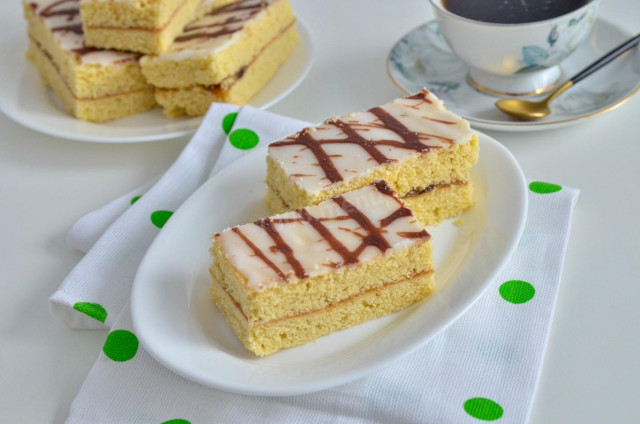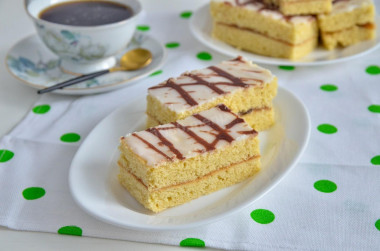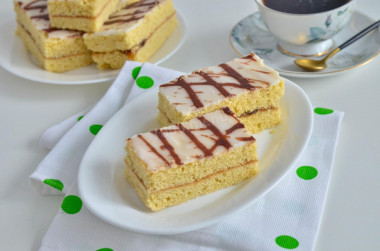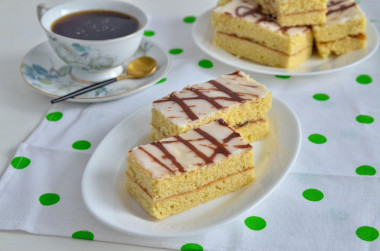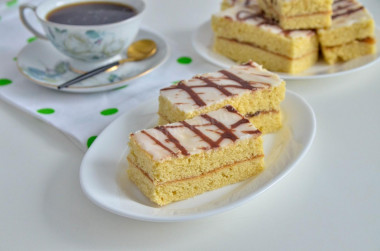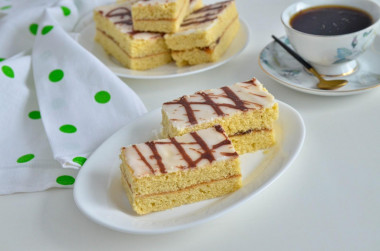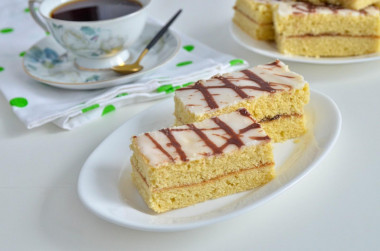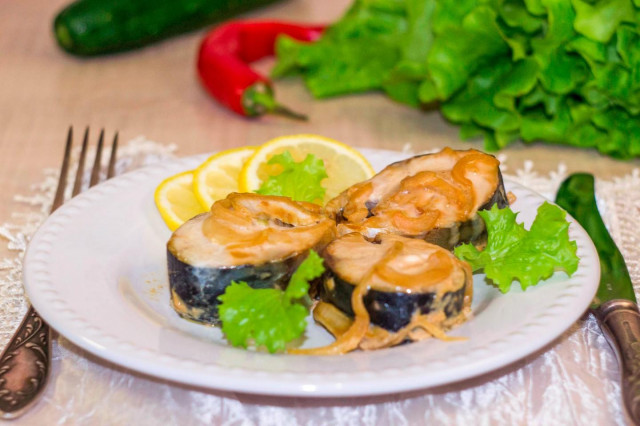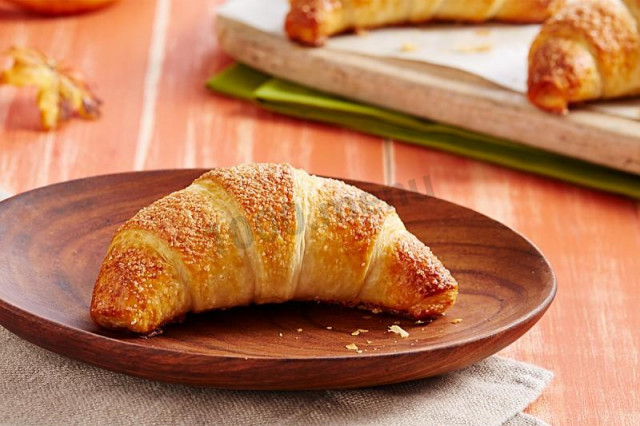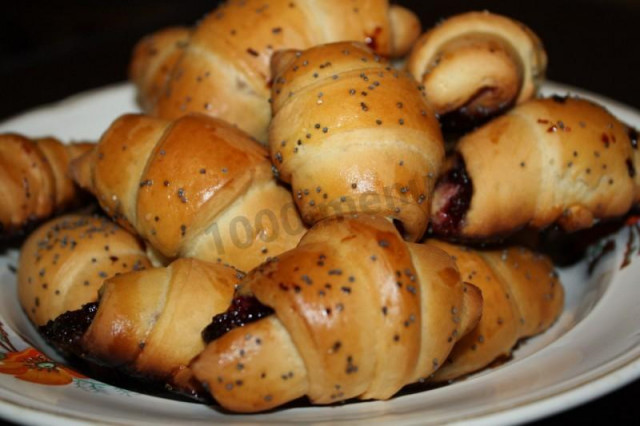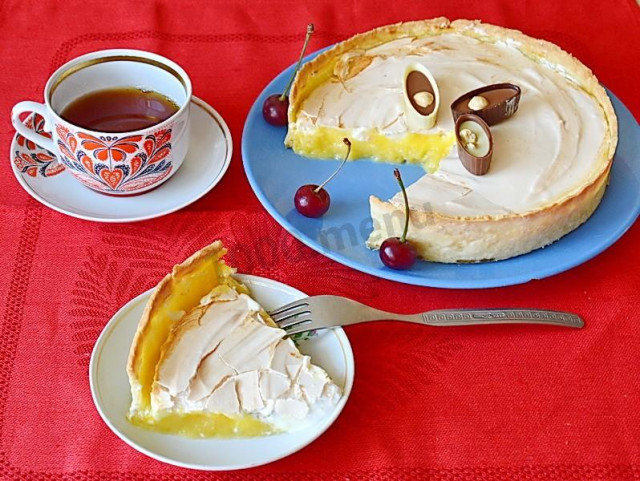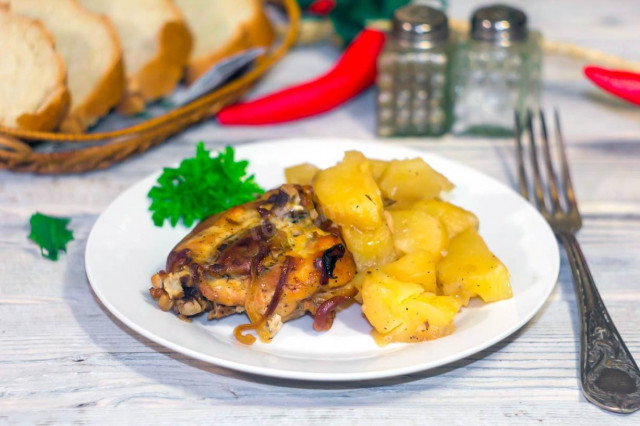Composition / ingredients
Step-by-step cooking
Step 1:
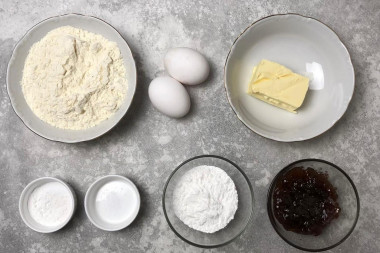
Prepare the products for making the cake. Take the butter out of the refrigerator in advance so that it becomes soft, we will beat it. It is better to take small eggs. Measure the flour exactly on the scales. Instead of powdered sugar, you can take fine sugar in the same amount. Take jam preferably with sourness - apricot, apple, plum.
Step 2:
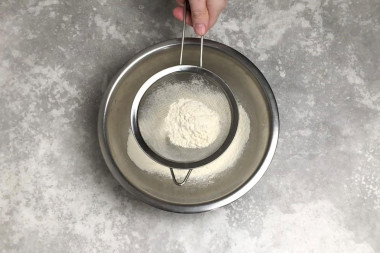
Sift the flour into a large bowl. Sifting flour saturates it with air, which makes baking more airy and soft.
Step 3:
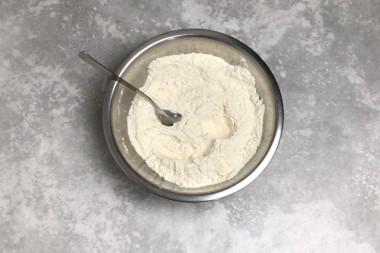
Add baking powder to the flour, mix so that it is evenly distributed over the flour. then the pastries will rise all the same.
Step 4:
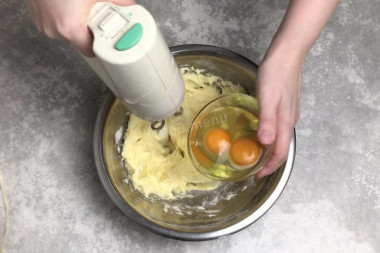
In another bowl, whisk the soft butter, powdered sugar and salt. I took a mixer and nozzles for the dough, as flour will be added next. When the butter and powder are mixed, add the eggs, pouring them one at a time. To do this, it is more convenient to break them in advance into a separate cup. Stir the mixture until smooth.
Step 5:
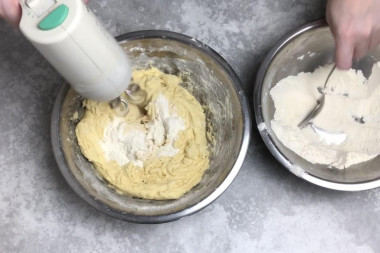
Without stopping whipping, start adding flour by spoonful. As soon as the portion of flour is mixed, add the next one.
Step 6:
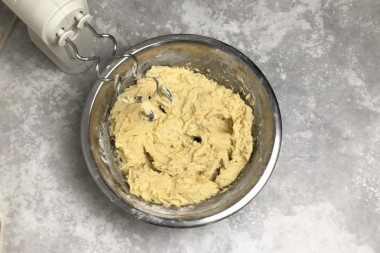
When all the flour is added, stir the dough for a couple more minutes. The result should be a very soft, but not sticky dough.
Step 7:
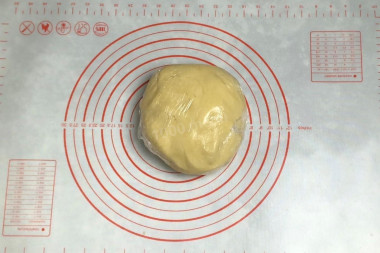
Assemble the dough into a ball, placing it on the work surface. If suddenly the dough seems still sticky, then add a little flour. But do not overdo it, otherwise the cake will turn out to be tough. I didn't add flour anymore. Wrap the dough ball in plastic wrap and put it in the refrigerator for 40 minutes.
Step 8:
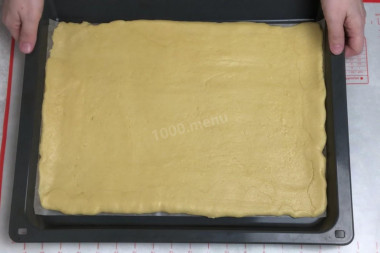
After the prescribed time, take out the dough. Roll it out into a rectangular layer. It is better to do this immediately on parchment of the size that the baking sheet will be. My baking tray is 30*40 cm. I cut off a piece of baking paper and rolled out the dough exactly on it. Try to make the dough the same thickness. Too thin dough will break after baking. That's how it turned out for me, one edge turned out to be too thin. Put the dough directly on the baking sheet in the refrigerator for an hour.
Step 9:
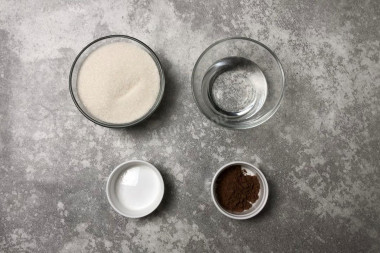
While the dough is cooling, prepare the sugar fudge. Ideally, it should be prepared a day before use, it should ripen. But, for lack of time, you can use quick cooking. Citric acid should be just a little bit, on the tip of a teaspoon.
Step 10:
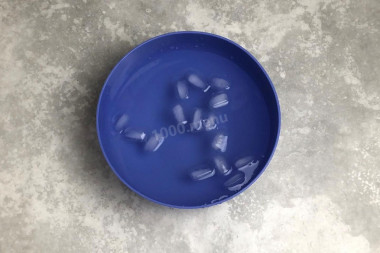
First prepare a basin with ice water, you will need to put sugar syrup in it to cool. Take this into account when choosing a size. Pour cold water into it and put ice cubes. Place the basin next to the stove so that it is at hand.
Step 11:
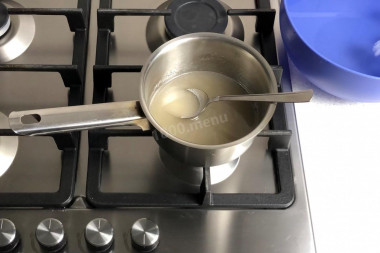
Pour water into a saucepan and add sugar. Put on medium heat, and, with constant stirring, achieve the dissolution of sugar.
Step 12:
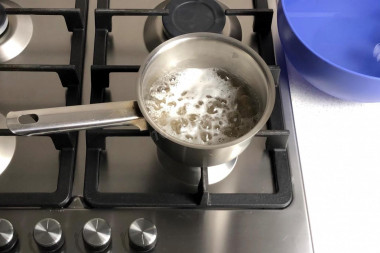
When the syrup boils, reduce the heat to a minimum. There is no need to interfere anymore.
Step 13:
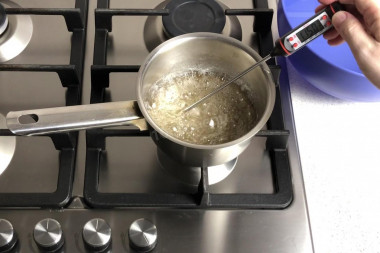
Cook the syrup for about 5 minutes. You will need a cooking thermometer to monitor the temperature. When the syrup is heated to 110 ° C, add citric acid. It is necessary to cook the syrup up to 115 ° C. As soon as it reaches this temperature, immediately remove it from the fire and put it in a prepared basin with ice water to stop further heating.
Step 14:
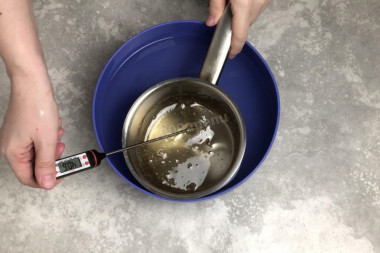
Cool the syrup to 40°C. Stir it with a spoon so that the syrup cools evenly. This will happen quite quickly, provided that the water in the basin is icy.
Step 15:
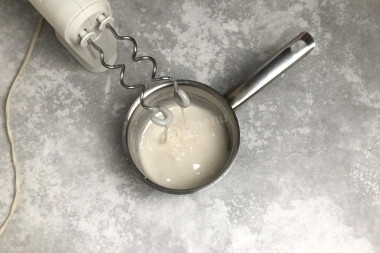
Beat the resulting syrup with a mixer until white. I got a rather viscous syrup, I had to take the nozzles for the dough. That's how we got the fudge.
Step 16:
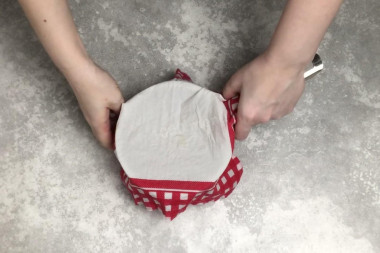
Cover the fudge dishes with a wet napkin. Squeeze the napkin well so that it does not drip. If you do everything according to the rules, then in this form the fudge should be held for a day. But we are in a hurry, and we will put it in the refrigerator for a while while the dough is baked and then cooled.
Step 17:
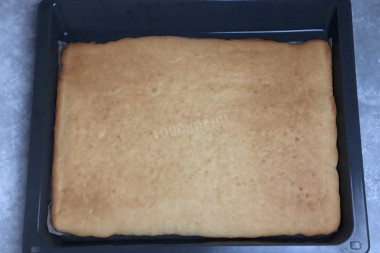
After an hour, remove the baking sheet with the dough from the refrigerator. Bake it in the oven, preheated to 210 ° C, for about 15 minutes, until golden brown.
Step 18:
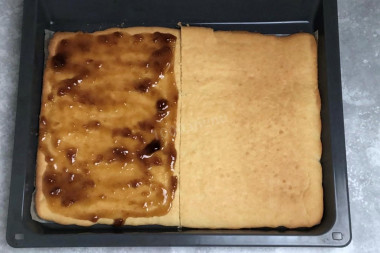
Take out the baked cake and immediately, while it is hot, cut it into two parts. The dough will become brittle after cooling, so you need to do everything quickly. Spread one half with jam.
Step 19:
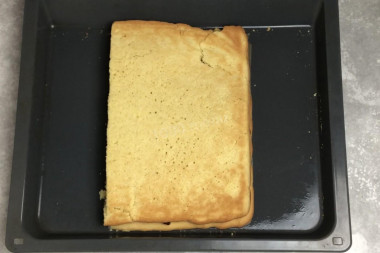
Cover it with the other half. This is where my thin edge broke, and later I had to cut it off. Leave the workpiece to cool completely.
Step 20:
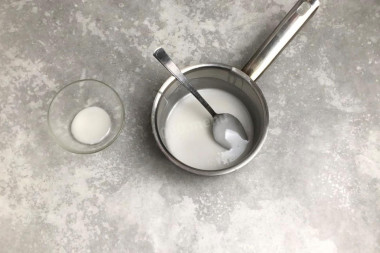
Take the fudge out of the refrigerator and heat it over low heat. At first it will be thick, but from heating it will become liquid. Pour one tablespoon of fudge.
Step 21:
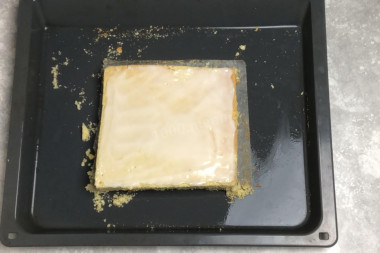
Spread the top of the cake with fudge, spread it with a spoon. I cut off the broken edge, and I just had enough fudge. So for a whole portion, it is better to increase its quantity.
Step 22:
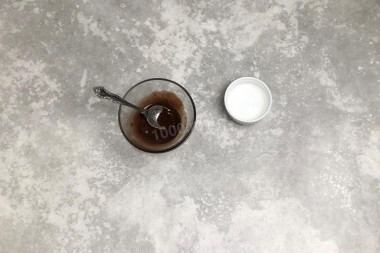
Add cocoa and a little water to the deferred portion. Stir until smooth.
Step 23:
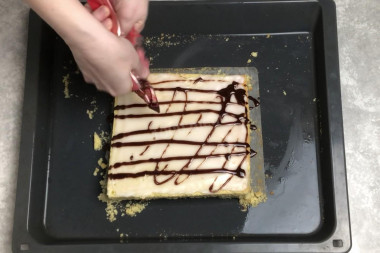
Pour the fudge into a tight bag, cut off the tip from it. Draw chocolate fudge patterns on top of white.
Step 24:
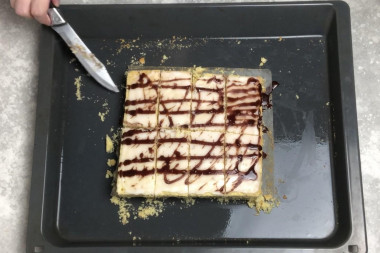
Let the fudge set, about 10 minutes. Cut the blank into rectangular cakes.
If you do not have a thermometer, then be guided by the time, as well as the sample for a soft ball. To do this, drop a drop of syrup into ice water and try to make a ball out of it. If it works out, the syrup is ready, if the drop is too sticky, cook further.
Fudge is a rather capricious dish. If you are not confident in your abilities, then pour the cake with melted chocolate. And you can cook chocolate icing. Another option is to use the cut edges of the workpiece as a sprinkling. Then brush the top layer with jam as well.
I really loved these cakes as a child, and therefore I made them with pleasure. It turned out to be the same School cake for 22 kopecks!
--------------------
Be prepared for the fact that flour may require a little more or, conversely, less than indicated in the recipe. You need to focus on how the dough should turn out (dense, soft, liquid, etc.). There is a lot of useful information about why flour, even of the same variety, can have completely different properties,
read this article
.
Keep in mind that everyone's ovens are different. The temperature and cooking time may differ from those specified in the recipe. To make any baked dish turn out successfully, use useful information in the article about ovens here .
Caloric content of the products possible in the composition of the dish
- Chicken egg - 157 kcal/100g
- Egg white - 45 kcal/100g
- Egg powder - 542 kcal/100g
- Egg yolk - 352 kcal/100g
- Ostrich egg - 118 kcal/100g
- Whole durum wheat flour fortified - 333 kcal/100g
- Whole durum wheat flour, universal - 364 kcal/100g
- Flour krupchatka - 348 kcal/100g
- Flour - 325 kcal/100g
- Granulated sugar - 398 kcal/100g
- Sugar - 398 kcal/100g
- Butter 82% - 734 kcal/100g
- Amateur unsalted butter - 709 kcal/100g
- Unsalted peasant butter - 661 kcal/100g
- Peasant salted butter - 652 kcal/100g
- Melted butter - 869 kcal/100g
- Apricot jam - 242 kcal/100g
- Jam - 250 kcal/100g
- Cocoa powder - 374 kcal/100g
- Citric acid - 0 kcal/100g
- Salt - 0 kcal/100g
- Water - 0 kcal/100g
- Baking powder - 79 kcal/100g
- Powdered sugar - 374 kcal/100g

